Peacocks are renowned for having lavish plumage and colorful tails. They never fail to astound people to see peacock tail feathers.
I assume you must have wondered at least once what the psyche of a marvelous peacock might be behind such grand behavior.
You are right, there’s a reason peacocks fan out their feathers on a train and create a display. Want to discover why the peacocks fan their feathers?
The peacock extends its resplendent feathers to intimidate potential threats, convey messages through vibrations to other peafowl, and captivate a mate during the breeding season. This magnificent display serves multiple purposes in the natural world, showcasing both beauty and survival instincts.
Peacocks are vibrant creatures that have plumage that is extremely large and patterned, which they fan out for exhibition.
Peacocks do not spread their feathers out of vanity; rather, it is a component of their courting behavior to attract a mating partner in the breeding season.
Peacocks also do the same when they feel threatened to deter the attacker from approaching. The predator is supposed to be intimidated by this show.
Keep learning more about this interesting creature in this article:
Why Do Peacocks Spread Their Feathers?
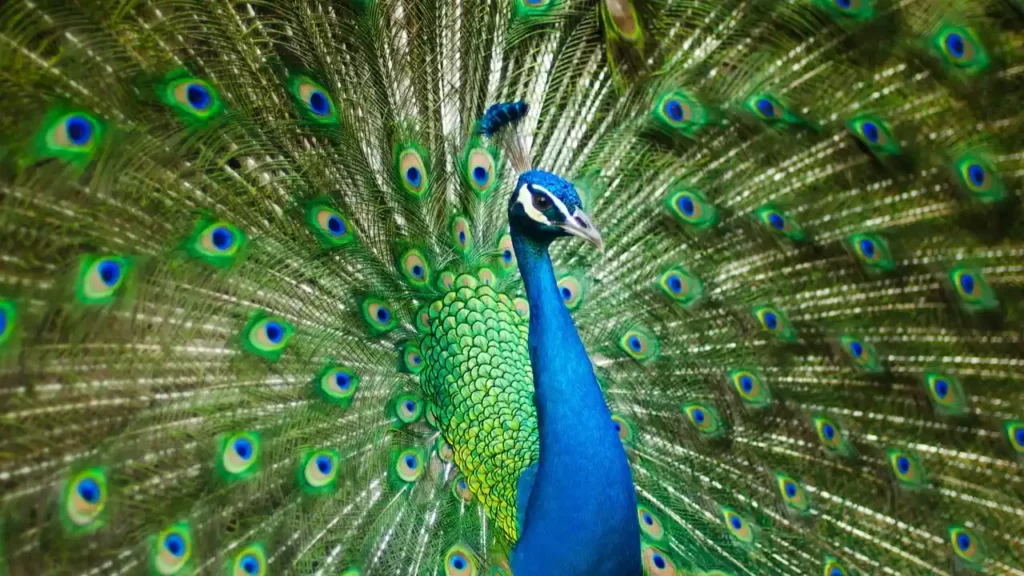
When you observe a peacock displaying its beautiful feathers, in all glory and strutting around, keep in mind that he is only attempting to impress a prospective partner.
When peacocks are wooing a partner, they frequently spread their feathers. Additionally, they could spread their feathers to flaunt their attractiveness.
The question might have an alternative response too depending upon the situation as peacocks do use their feathers to scare away natural predators, or when they are attempting to frighten a rival.
All in all, peacocks unfold their feathers to display how large and magnificent they are. Alternatively, they spread their feathers when they’re scavenging for food, avoiding predators, or asserting dominance over their territory.
Some of the reasons for peacock spreading their feathers are described below in detail:
To Attract Mates
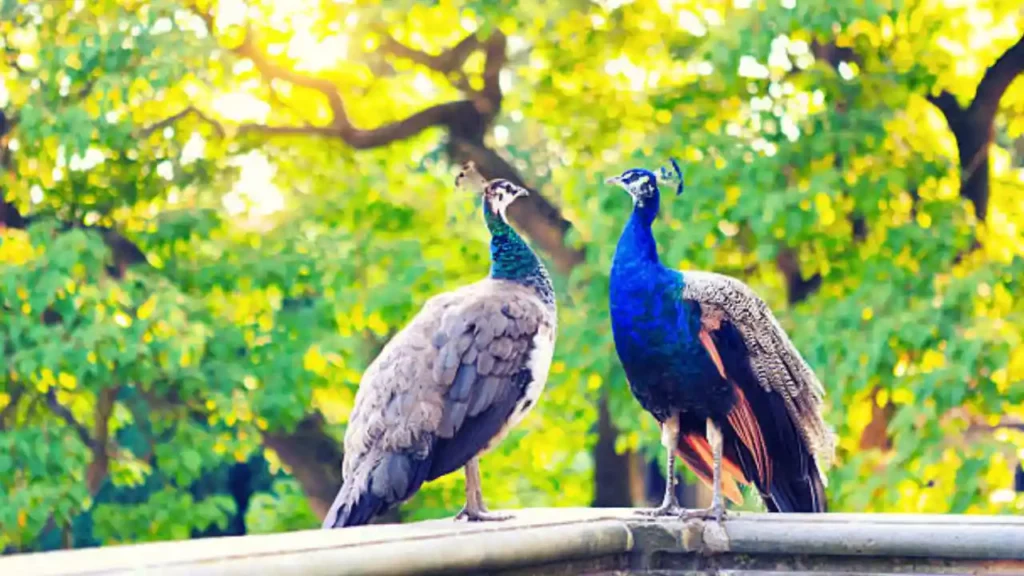
Many of you might be unaware that peacocks frequently engage in fierce competition with one another in order to attract a peahen.
Peacocks have magnificent feathers, so they spread them out and shake them majestically to entice a partner.
The peacock therefore expands its feathers and rattles a little to attract the peahen’s attention because courting a peahen is part of its survivalist function.
Sometimes they even follow the peahens to draw their attention.
According to research on evolution, the spreading of a male peafowl and a female peahen’s feathers is an evolutionary trait required to start mating, which is then required for the purpose of preserving the diversity of species in their natural habitat.
Practically all mammals exhibit this habit. Animals’ genes generally include traits like bragging and grooming that are used to entice a partner.
It is a biologically and genetically inherited trait to dazzle the opposing sex in order to entice them to mate through a courting show.
Additionally, the spreading of feathers serves as a representation of visual superiority amongst peacocks of the same sexes.
Regardless of the variations in their species, all peacocks use their tail to lure a partner for mating during the breeding season.
Oftentimes, the spreading of feathers is accompanied by a pompous dance that accentuates their physical beauty.
To Scare Away Predators Or Rivals

Peacocks stretch their tail feathers when they are afraid or feel intimidated. This is an attempt to scare predators and frighten off prospective predators.
Peacocks only have a few tools at their disposal for self-defense: they are superb runners, they can fly short distances so that they can fly up to a perch, where they are out of reach of predators. The spreading of feathers is yet another instrument for peacocks to save themselves.
Peacocks exhibit their feathers as a defense mechanism against potential threats when they get fearful.
When confronted by rival peacocks, when danger is close, or when people approach them, they engage in this behavior.
Often, predators like tigers, leopards, eagles, cats, bobcats, owls, and dogs get attracted to peacocks because of their dazzling colors because they assume that they can relish a tasty meal upon killing a peacock.
In an effort to scare off attackers including tigers, leopards, dogs, owls, hawks, eagles, huge cats, bobcats, and jackals, the tiger unfolds his dazzling blue, green, and gold feathers so that the attacker gets frightened by the overwhelming display.
Another example of such a defense mechanism is also the spurs present on the male peacock’s feet.
What Is Aposematism?
Aposematism and crypsis are two forms of protective behavior that are operationally opposed in living things.
Predators are kept at bay by birds displaying both sorts of behaviors. They are therefore a type of animal’s or bird’s defense system.
By signaling to prospective attackers that it is not worth killing or consuming, an animal engages in aposematism.
Aposematism is the act of an animal or bird signaling to other predatory animals that there is danger involved in attacking or consuming that animal or bird.
This danger might include any defenses that make the prey challenging to kill and consume, including toxicity, venom, an unpleasant smell or taste, jagged spines, or aggressive behavior.
The act of male peacocks spread their feathers is an act of aposematism where they try to scare the predator away by unfolding their train and enlarging themselves in size.
To Communicate With Each Other Peacocks

It is a recent finding that peacocks also communicate by spreading their feathers. They make low-pitched sounds- below 20 hertzs-by rustling their feathers which produces infrasonic sound.
Since so many people are intimately acquainted with the agonizingly loud screeches of peacocks, it had long been understood that peacocks and other species can communicate through vocalization.
However, the finding of this kind of inaudible cry illuminates a distinct form of communication, which humans have typically found difficult to observe since it is outside the range of our regular hearing.
Researchers discovered that male peacocks make two very subtle variations of infrasonic mating calls.
The first kind, which researchers called the “shiver train,” is caused by vibrations that radiate from the center of the feathers to the edge of the plumage.
This infrasonic call is produced by the rattling of feathers and is given when the peahens are located far away.
The second kind, known as the “pulse train,” is given when females are nearby and is brought on by vibrations that come from the base of every feather in the train.
Additionally, peacocks also spread their feathers to communicate their feelings of joy and excitement. They flaunt their feathers when they are joyful and delighted.
When they are unrestrained and in an open space with lots of food and no immediate threats, they frequently fan out their feathers and strut around. Usually, you may spot them in a park or zoo around this time.
What Is It Called When A Peacock Spead Its Feathers?
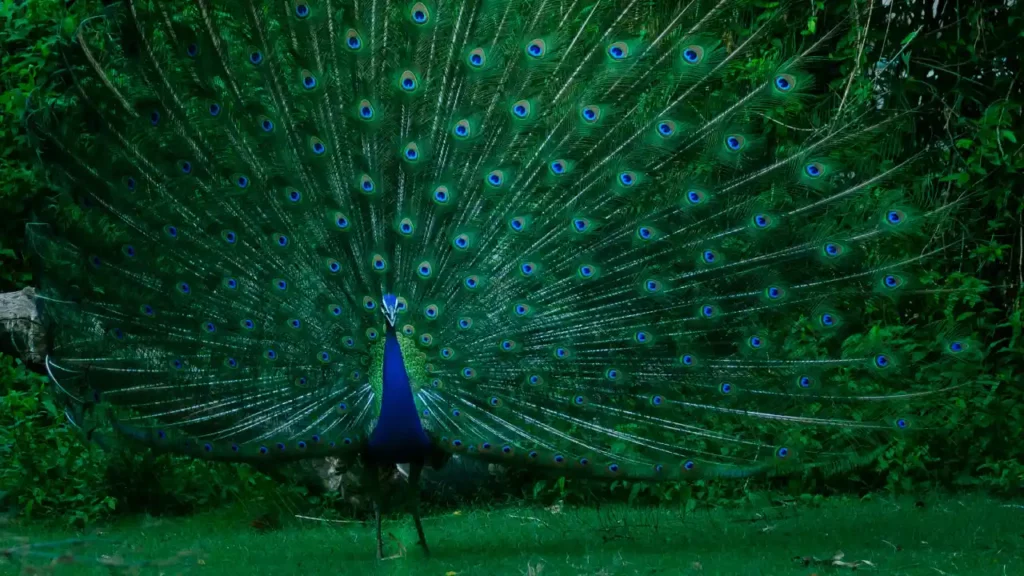
When a peacock spreads its feathers, it is referred to as “displaying”. This behavior is used by the male peacocks to attract potential mates and also to communicate their social status to other birds. The color of the feathers and how they are displayed is an indication of how healthy the bird is as well as a way for them to show off.
When a peacock displays, its feathers fan out in full glory to create an extravagant display. The size of the display can vary depending on the species and how healthy the bird is. Additionally, as a way of intimidating rivals, they may also do a shorter version of this behavior that has been described as “a flaring sunburst”.
The amazing beauty created by the peacock’s display has long been admired, and it is even considered to be a symbol of beauty in many cultures. To this day, people often use pictures or sculptures of peacocks to represent beauty and elegance in interior design.
The peacock is also one of the few animals that can produce sounds as well as visual displays. When displaying, the peacock produces a loud call that has been described as sounding like a “shrill scream”. This sound is another way of attracting potential mates.
All in all, when a peacock spreads its feathers it is called displaying and is used to communicate its social status and attract potential mates. This behavior creates an amazing sight of beauty and elegance, and the peacock feather is often used to represent these qualities in art and design.
Which Peacock Spread Their Feathers Male or Female?
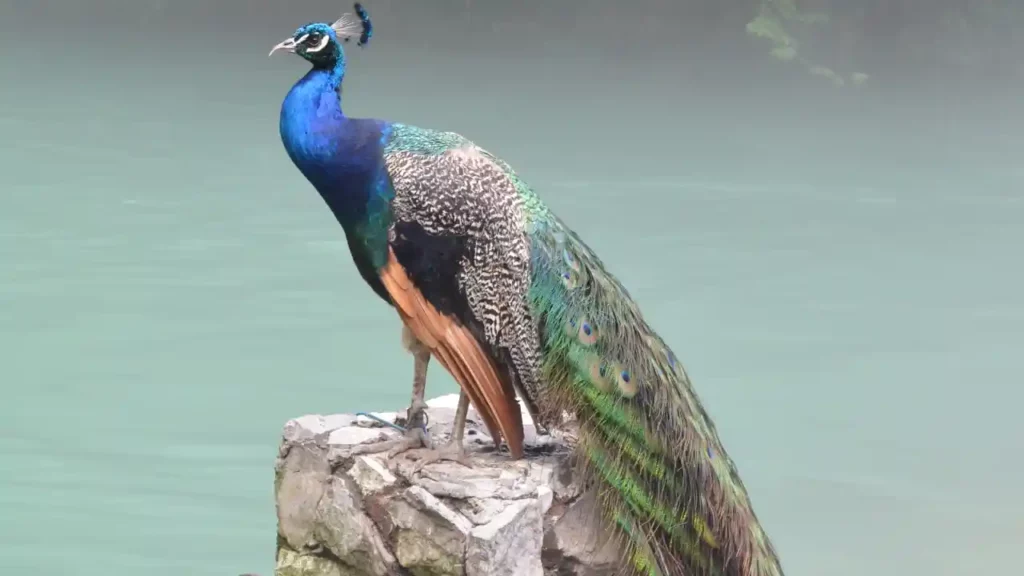
Everyone knows that peacocks are well known for their impressive feathered displays. But did you know that it is actually only the male of the species that spread their feathers? The female doesn’t possess the extravagant peacock’s tail and appears to be a much more understated bird in comparison.
The beautiful, iridescent feathers of the male’s tail serve one purpose; to attract a mate. In addition, the male also spreads his feathers in order to assert dominance over other males and protect his territory. All of this is possible thanks to an extension of feathers called a train which grows from their tail.
Interestingly enough, the fanning out of the peacock’s feathers is not always done for the courtship ritual purposes. It may also be done to help the peacock cool down in hot weather. The movement of air between the feathers creates a cooling effect which helps the bird regulate its body temperature in warm climates.
So, next time you see a peacock strutting its stuff, remember it is likely that he is looking for love and not just cooling off!
How Do Peacocks Communicate With Each Other?

Peacocks communicate with each other through visual and vocal signals. These signals are used to express dominance, attract mates, communicate danger or alarm, and show off.
Visual signals are usually in the form of displays such as spreading their feathers to create an extravagant display. This behavior is used by males to compete for mates and also as a way of communicating their social status. The size of the display varies depending on the species and how healthy the bird is. Additionally, peacocks will sometimes do a shorter version of this behavior that has been described as “a flaring sunburst”.
Vocal signals are also used by peacocks to communicate with each other. The most common vocalization is a loud call which has been described as sounding like a “shrill scream”. This sound is usually used by males to attract potential mates. Peacocks also produce other vocalizations such as clicking and clucking noises which are used as alarms or warnings of danger.
Fun Facts About Peacock Feathers
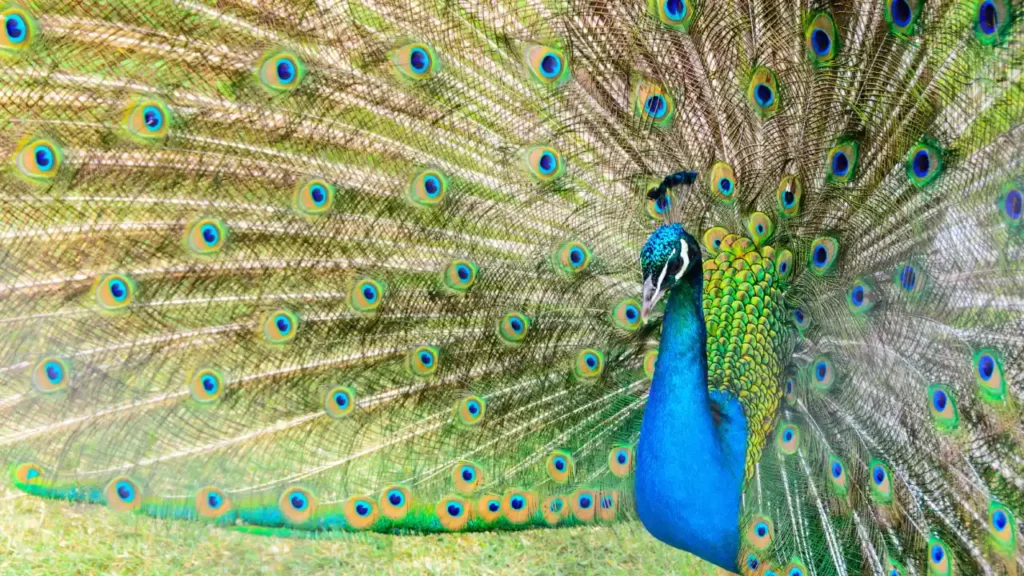
Enough with the dull knowledge! Now, let’s learn some fun facts about male peacock feathers:
Male and female peachicks have the same appearance upon hatching and for several months following.
Males don’t begin to acquire color until they are around three months old, and peacock’s tail feathers don’t become brilliantly coloured until they are three years old and have reached full maturation.
Peacock feathers eventually fall off and are substituted by fresh ones, just as human skin cells. Male peacocks shed their feathers at the conclusion of every mating season.
Peacocks stop flapping their long tail feathers around the end of the summer, and their beautiful plumage gradually dries off.
Most birds go through this process of shedding their feathers called molting. Since feathers don’t regenerate on their own, birds must completely replace them when they become worn out or lose their usefulness.
Similar biological changes take place throughout this molting process as when snakes lose their skin.
Final Thoughts
Peacocks spread their feathers in an effort to attract female peacocks or scare away predators when they feel threatened.
Additionally, they may stretch their train to demonstrate affection, attract attention from their female peafowl elsewhere, and inflate their size to terrify any adversaries or rivals.
Sources:
- Kannan, R. and D. A. James (2020). Indian Peafowl (Pavo cristatus), version 1.0. In Birds of the World (S. M. Billerman, Editor). Cornell Lab of Ornithology, Ithaca, NY, USA. https://doi.org/10.2173/bow.compea.01
- Jordania, J. (2021). Can there be an Alternative Evolutionary Reason Behind the Peacock’s Impressive Train. Academia Letters.
- Peacock – The Rise and Fall of a Symbol – Joseph Jordania
- Peafowl and Their Care By Waldo Lee McAtee – 1931
- The Encyclopedia of Birds Book
- Petrie, M., Tim, H., & Carolyn, S. (1991). Peahens prefer peacocks with elaborate trains. Animal Behaviour, 41(2), 323-331.

